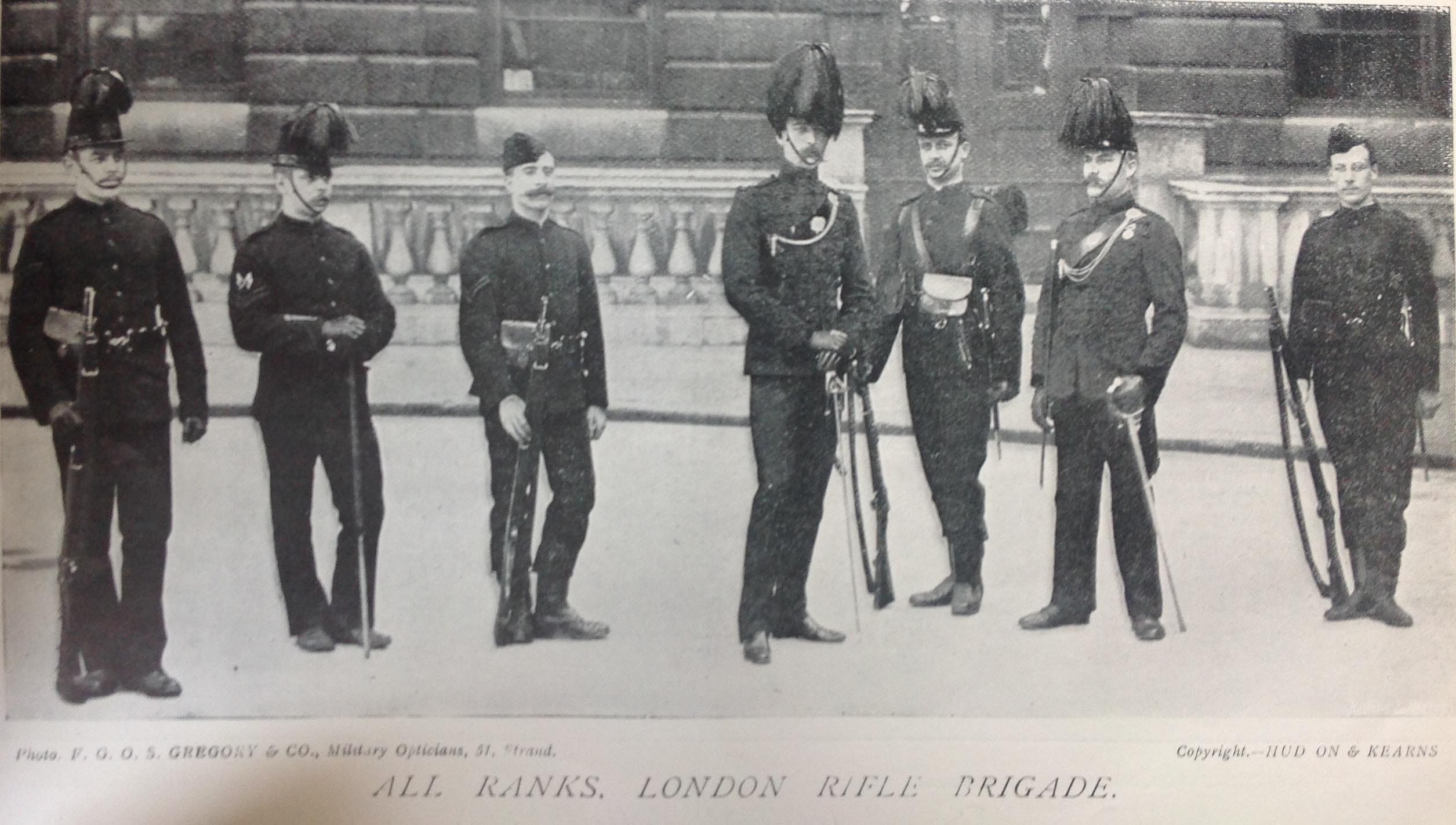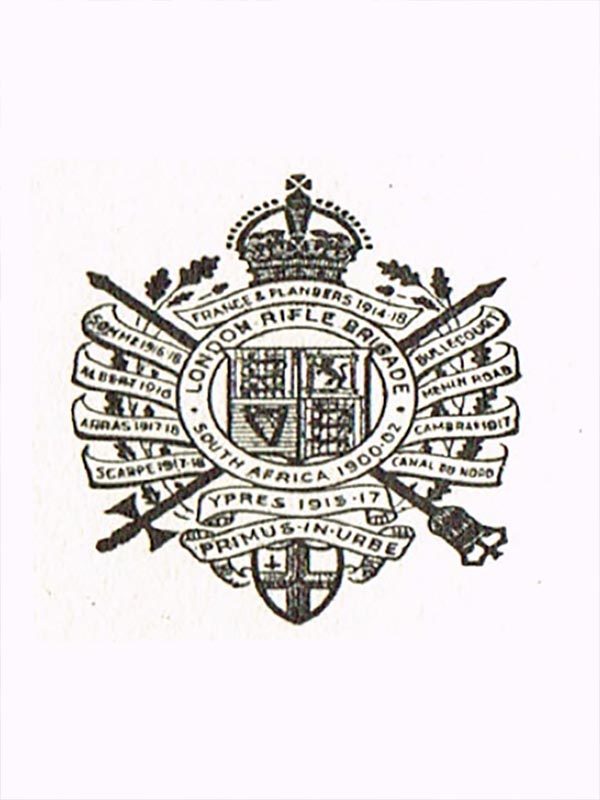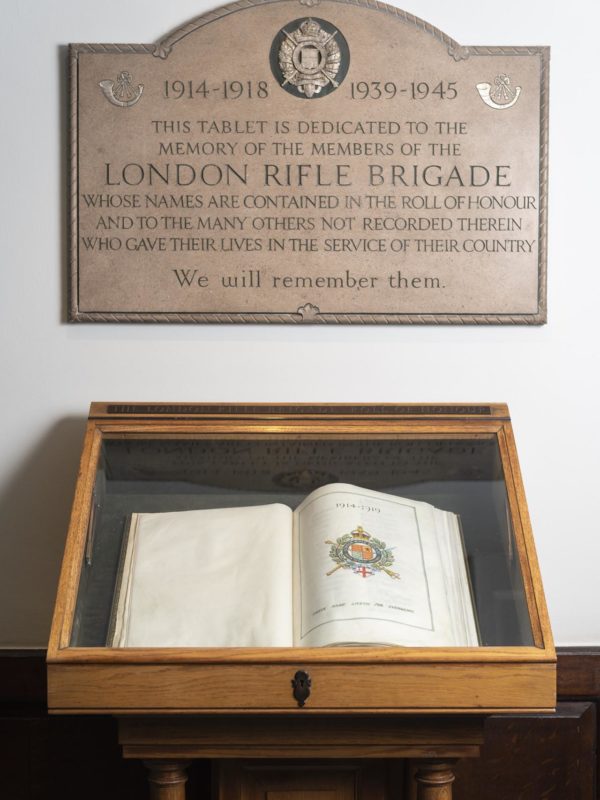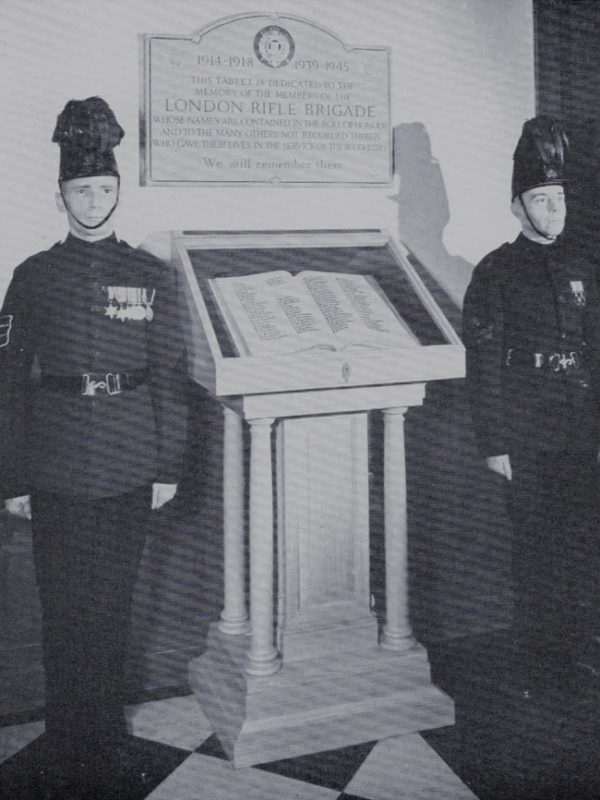At that time Great Britain felt itself threatened by France, then ruled by Napoleon III and the Secretary of State for War wrote to all the Lords Lieutenant of the counties and shires authorising them to raise Volunteer Rifle Corps for the defence of the country. In this endeavour the City of London was at first overlooked but enthusiasm soon made up for lost time.
Recruiting in the City of London went well and the 1st London Rifle Volunteer Brigade were told that they could retain the word “Brigade” in their title provided they raised sufficient men for two battalions. Recruiting men from the City business houses this was achieved within a week of the start of recruiting when the numbers exceeded 1,800 men. The corps were subsequently known as the “L.R.B.”
In 1866 the L.R.B. provided a company for a composite battalion going to Brussels for a shooting competition, the enthusiastic and welcoming manner in which these British troops were received, the first seen there since Waterloo, suggests that perhaps Britain was not the only country to feel threatened as Prussia had just defeated Austria and were supposed in some quarters to be turning their thoughts to Belgium.
Despite modelling themselves on the Rifle Brigade since 1859, in 1881 the L.R.B. were allocated to the Kings Royal Rifle Corps as a Volunteer battalion.
The Rifle Volunteer Corps were not permitted to serve overseas but some 140 men of the L.R.B. fought in the Boer War having temporarily transferred to the City Imperial Volunteers, the Service Company of the Royal Fusiliers (City of London) Regiment, the Imperial Yeomanry, the R.A.M.C. or the Army Service Corps. In common with many other Rifle Volunteer Corps throughout the country the L.R.B. were awarded the battle honour “South Africa 1900 – 02”.
In 1908 the Rifle Volunteer Corps throughout the country were disbanded but invited to continue as battalions of the new Territorial Force. The L.R.B. became the “5th (City of London) Battalion (London Rifle Brigade) The London Regiment”. The London Rifle Brigade served in the First World War in their own name, with L/Sgt Douglas Belcher gaining the Victoria Cross on the 13th May 1915 for his gallantry in defending a flank position with nine men. In the Second World War the L.R.B. served as the 7th Battalion Rifle Brigade (1st Btn London Rifle Brigade) and the 8th Battalion Rifle Brigade (2nd Btn London Rifle Brigade). In 1950 the London Rifle Brigade amalgamated with the 12th County of London Battalion (Rangers) The London Regiment becoming the “London Rifle Brigade Rangers”. The L.R.B. subsequently became “C” Company, 4th Volunteer Battalion the Royal Green Jackets which in turn became part of “F” Company, 7th Battalion The Rifles. This successor unit continues the traditions of the L.R.B. by providing a Guard of Honour for the Lord Mayor’s Banquet and a presence at the Lloyd’s of London Remembrance Service in November.
St. Botolph’s Church has in its keeping the L.R.B.’s Book of Remembrance which records the dead of both World Wars, it was originally dedicated, with two silver candlesticks, by the L.R.B. Chaplain, the Bishop of London, Doctor Winnington-Ingram, on the 27th January 1923 in St. Pauls Cathedral. On Sunday, November 5th 1950 after the names of those who fell during the Second World War had been added it was rededicated with a memorial wall plaque and oak case at St. Botolph’s by the Right Reverend Guy Vernon Smith, M.C. D.D., Lord Bishop of Leicester, who had been Chaplain to the 2nd Battalion L.R.B. 1914-1917. In total some two thousand and thirty-eight names are recorded. The serving members attending wore full dress of “Greens” with chakos and cockades. The candlesticks, largely made from silver sports trophies and medals donated by serving men or widows of members, remain in the Kitchener Memorial Chapel in St. Pauls.
The 12th County of London Battalion (Rangers) were raised at Gray’s Inn in 1860 as the “40th Middlesex Rifle Volunteer Corps” with the subsidiary title of the “Gray’s Inn Rifle Rangers” only to change this months later to the “Central London Rifle Rangers”. In 1880 they were renumbered the 22nd Middlesex Rifle Volunteer Corps and in 1881 they joined the Royal Fusiliers (City of London) Regiment as one of their volunteer battalions. In 1882 they were reallocated to the Kings Royal Rifle Corps and in 1908 became the 12th County of London Battalion, The London Regiment. They served during the First World War in their own name and in the Second World War served as the 9th and 10th Battalions of the King’s Royal Rifle Corps. After suffering heavy losses in the Desert they amalgamated with the London Rifle Brigade in 1950.
A further military connection with St Botolph’s is recorded by the following inscription on a plaque on the South side of the nave which reads:-
7th (City of London) Battalion The London Regiment T.A.
These Colours laid up on 23rd September 1962 were
presented to the Regiment by H.M. King Edward VII
at Windsor Castle 19th June 1909
The 7th (City of London) Battalion, The London Regiment was raised in 1861 as the 3rd City of London Rifle Volunteer Corps and because they wore brass buttons, instead of the usual black buttons of a rifle corps, they obtained the nickname, “The Shiny Seventh”. The regiment claimed descent from the Yellow Regiment of London Trained Bands, the Temple Bar and St Paul’s Association (1798–1802) and the Third Regiment of Loyal London Volunteers (1803), but these units had been disbanded long before. In 1881 they were allocated to the King’s Royal Rifle Corps as the 11th Volunteer Battalion. In 1908 they transferred to the Territorial Force as the 7th (City of London) Battalion, The London Regiment. Between wars they transferred to an anti-aircraft role and after a number of re-designations by 1949 became the 567 (Mixed) Light Anti-Aircraft/Searchlight Regiment, RA (TA). When AA Command was disbanded in 1955, the regiment was merged into 265 Light Anti-Aircraft Regiment, RA, becoming ‘P’ (7th City of London) Battery. The Colours are currently displayed on the drill hall wall of the 265 (HC) Air Assault Battery Royal Artillery, Napier House Drill Hall, Baring Road, Grove Park, SE12 0BH.









